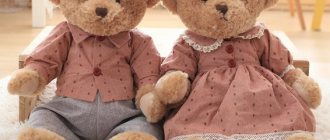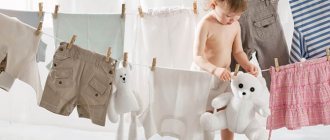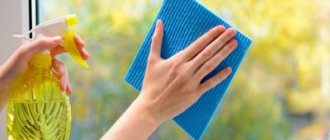From this article you will learn:
- Key questions about caring for soft toys
- A little about mites and bacteria
- Recommendations that will not harm toys
Most likely, there is a small child in your house. And the mountains—immense mountains—of toys. Especially soft ones. Right? Soft toys, like all others, are divided into two groups: favorite ones - those with which the baby constantly interacts. And irrelevant ones are those that have been forgotten for some time. It is interesting that toys do not constantly occupy one niche, but from time to time they move from one group to another. Thus, the parent must be sure of the cleanliness of every soft toy in his home.
Hmm, are “homemade” toys really dirty? - they are not taken out into the street, they are not touched with dirty hands... But no one has canceled the presence of dust, even among the most responsible housewives. And when a baby hugs his plush pet, drags it across the floor, then puts it in his bed, tastes a toy ear or nose, the question arises of how to care for soft toys so that they are safe for the child.
But there are also “street” plush toys. A sandbox, a puddle, hands sticky from food - all this threatens the appearance of not just dust, but the most natural dirt. It turns out that washing plush toys is the most necessary measure in using these products. Otherwise, all the surrounding dirt will end up on and in the child himself. So how should you care for soft toys? Is everything transparent in this process or are there any difficulties?
Key questions about caring for soft toys
How often? The first tip is to wash (clean) when dirty. It makes sense to refresh a child’s favorite item once (twice) a month. Don’t rush to wash or clean your stuffed toy right away. First, examine its condition: it is better to hem a torn side or a barely holding ear before washing. And, of course, batteries and other elements that are afraid of water require attention - either you need to take them out, or choose a steamy cleaning option. In this case, dry cleaning with a vacuum cleaner, a bag of starch or the use of hot steam is suitable. Using a vacuum cleaner, take a special small attachment - there are some that are used to clean upholstered furniture. Also, if possible, use one of the lowest suction modes. Please note that vacuuming is suitable for large toys with long pile. And for smaller products, you need to take a plastic bag in which you put the toys themselves and 5 tablespoons of soda or starch. Close the bag and shake it for several minutes. Then we take out the products and clean them with a brush over the bathtub. It is possible to remove dirt from a fleecy surface well with the help of soda and starch. And another method is to use hot steam. It disinfects toys and rids them not only of dust, but also of other contaminants (read about it below). You can take an iron with a vertical mode, a steam cleaner, or a household clothes steamer.
How? An equally important tip is to be sure to study the composition of the toy and the features of its care. All this can be found on the label and tag. Thus, you will understand which wash to choose - hand, machine (and in the latter case - in what mode: delicate or standard). Hand washing options are possible in a variety of situations:
- If the composition of the toy is heterogeneous and there are glued parts;
- if the product has inserts made of painted plastic, they may be damaged in the washing machine;
- when the toy is filled with sawdust, rice, buckwheat husks, straw, cotton wool;
- when the product is very soft, which can cause it to stretch and deform.
How? There are special powders for children's clothing. If the water is too hard, you can give preference to washing gels with the addition of conditioner. Some housewives offer homemade detergent compositions to get rid of individual stains:
- You need to mix three tablespoons of liquid soap, a quarter spoon of ammonia and three quarters of a glass of water. After whipping the composition, apply exclusively foam to the stains. And then wash everything off with a damp cloth.
- to a quarter glass of water add half a glass of rubbing alcohol and half a tablespoon of laundry soap.
What then? After stripping, you need to let the toy dry, this is logical. But how? Some “shaggy hair” should be thoroughly combed, straightened and dried in a warm place, not in direct sunlight. For combing, get a separate, new and clean comb so that the grease from a previously used comb does not settle on the washed product. But for knitted toys, hanging will be completely unacceptable, because during drying the yarn will begin to stretch and deform. Here the advice is clear: dry knitted items on a terry horizontal surface.
Special situations. This is when the toy is either heavily soiled or cannot be cleaned at home. Then an out-of-home method comes to the rescue - the well-known dry cleaning in a salon. Expensive. But for the sake of the child, you will have to sacrifice financial costs.
Handwash
The most delicate type of cleaning would be washing toys by hand. It will allow you to carefully and thoroughly remove dirt without damaging the material and filler. But such a process takes a long time and is quite labor-intensive.
ARTICLE FOR YOU
How to properly wash a ski suit: in the washing machine and by hand
Most soft toys can be machine washed, with the following exceptions:
- musical toys;
- interactive and with lighting effects;
- expensive and collectible items;
- products with ball filler.
Hand washing toys
The washing algorithm itself is quite simple:
- first of all, you need to prepare the toys, remove the batteries and mechanisms;
- for severe stains, pre-soaking in warm water with detergent for fifteen minutes is possible;
- water for washing should not exceed forty degrees;
- stains can be rubbed with a soft brush or sponge;
- After washing, you need to rinse everything well;
- The products are gently wrung out with a towel and dried.
If there is little contamination and you only need to refresh the material, you can limit yourself to wet cleaning. To do this, prepare a soap solution, which is foamed with a sponge and applied to the product.
Residues of detergent are removed with a wrung out sponge or napkin. This method is suitable for large toys or those that cannot be wet.
A little about mites and bacteria
Did you know that dust mites can cause allergies and asthma? If dust is everywhere, then the question is: why doesn’t everyone around us suffer from allergies? The answer to the question will be the subject of another article. And to figure out how to care for plush toys, we just need to know that the human body is a self-regulating system. And we ourselves must help this regulation.
Experienced housewives claim that one of the effective ways to clean soft toys from dust mites and pathogenic bacteria is to freeze the product in the freezer for 72 hours. By the way, keep in mind that you need to put toys folded in plastic bags in the freezer. And if it’s winter, taking the products out into the extreme cold will help deal with contamination. They also say that ultraviolet has the same properties in the fight against pollution as cold temperature. But even after such exposure, the product still has to be washed - to wash away the pests that you have frozen.
How often to clean toys
It all depends on how often your child plays with them. Here are the general rules:
- Rubber and hard plastic toys are the easiest to care for. If they are used daily, clean and disinfect them once a week.
- Wash soft toys with which the child sleeps and often interacts in the washing machine once a week. The rest can be washed once every two weeks (or even less often if they are just sitting in a box). We'll talk about those that can't be washed below.
- Wipe electronic toys with a disinfectant wipe once a week.
- Small toys that are most often put in the mouth and thrown on the floor require special attention. Wash them every day or every other day.
Also don’t forget: when a child is sick, toys need to be cleaned more often. And after recovery, be sure to disinfect them again.
Take note











